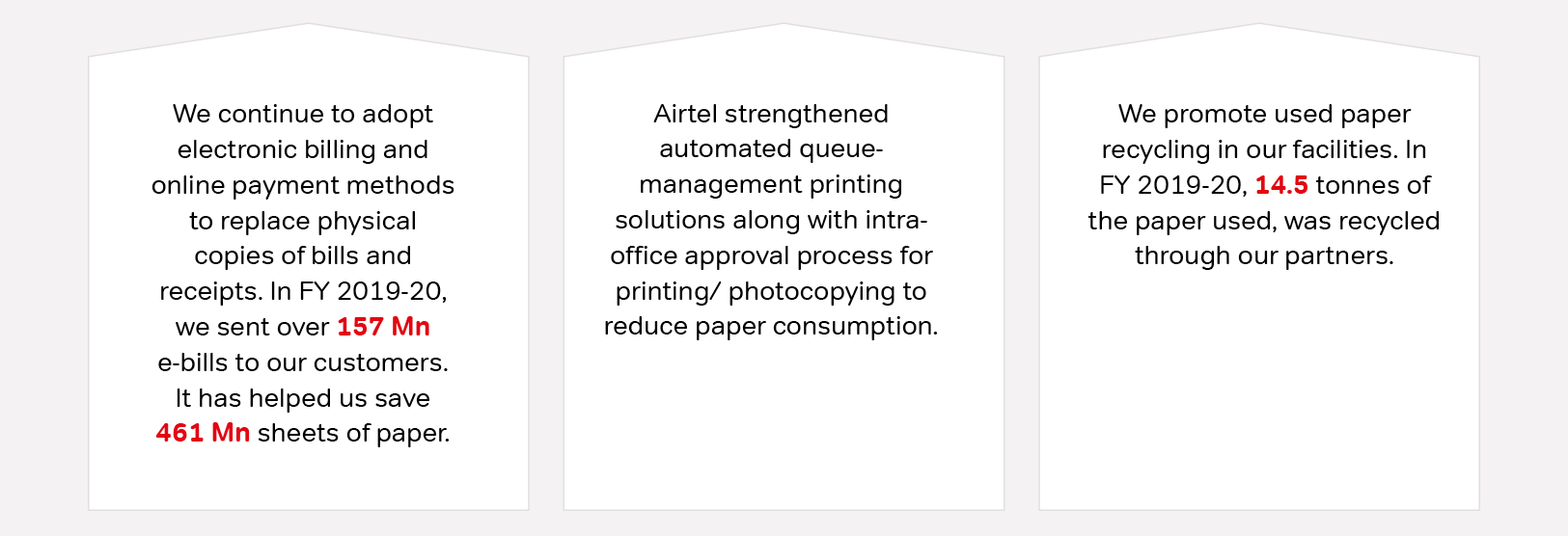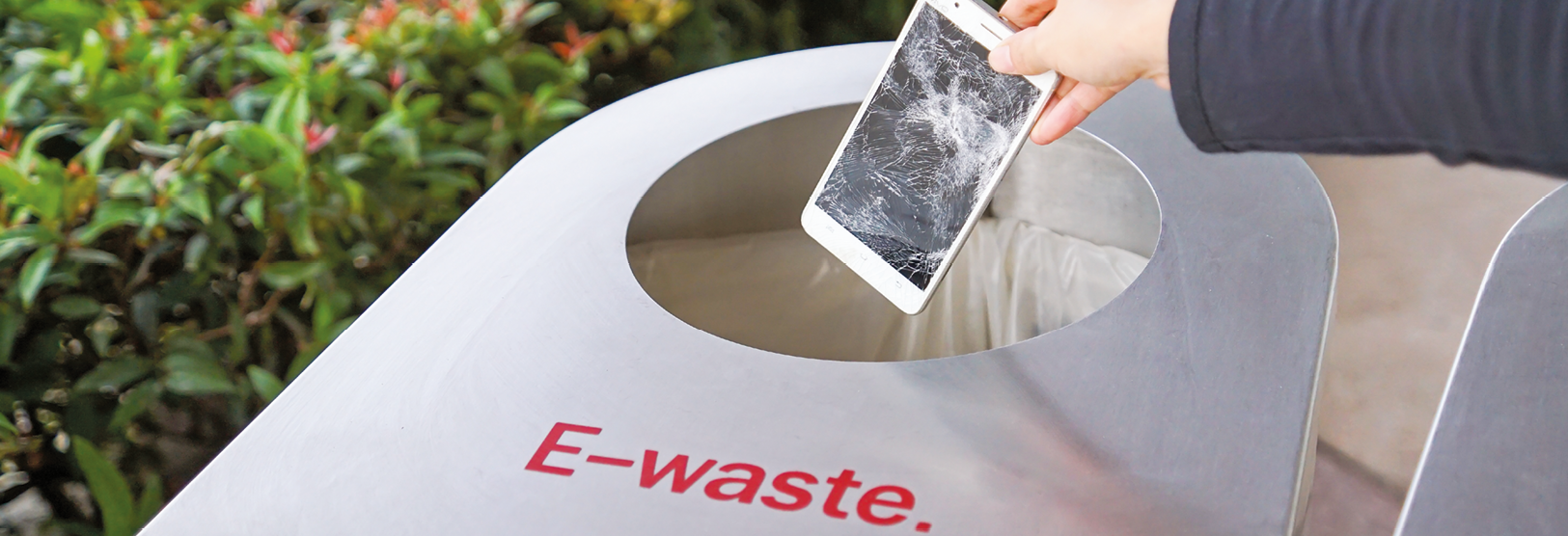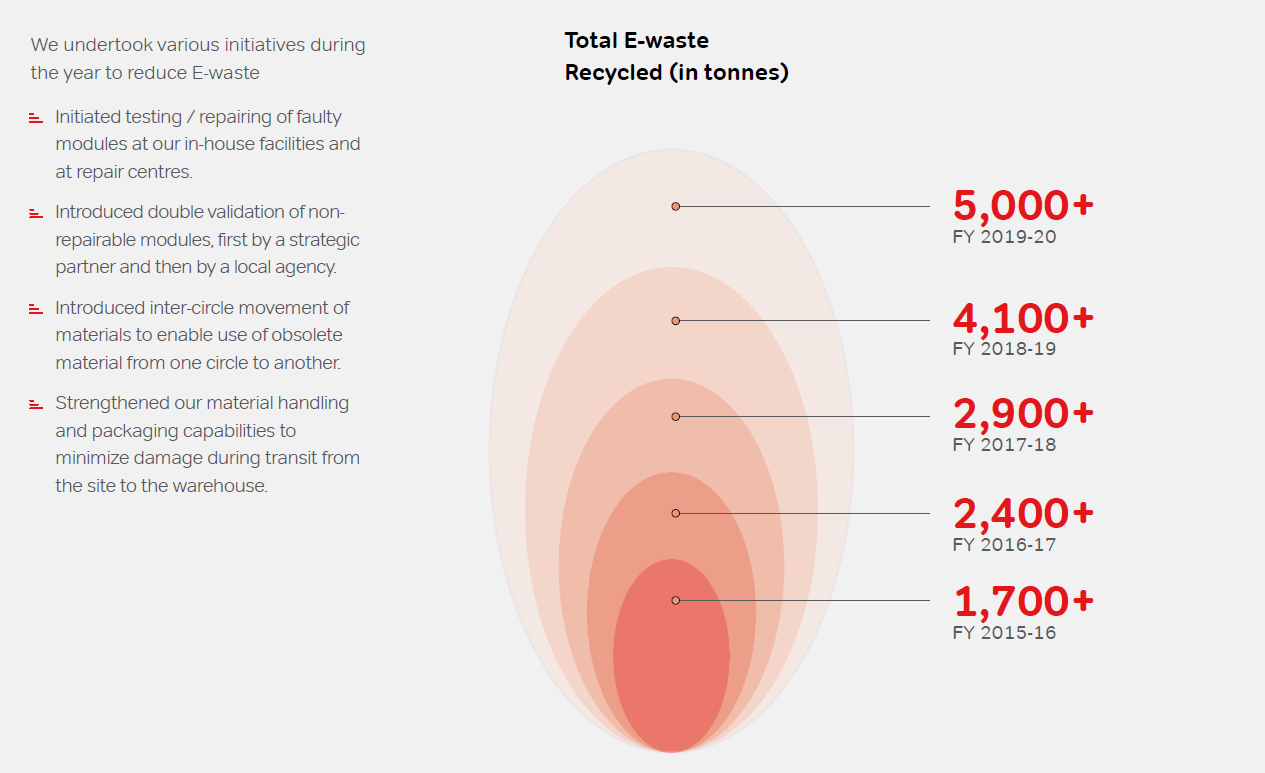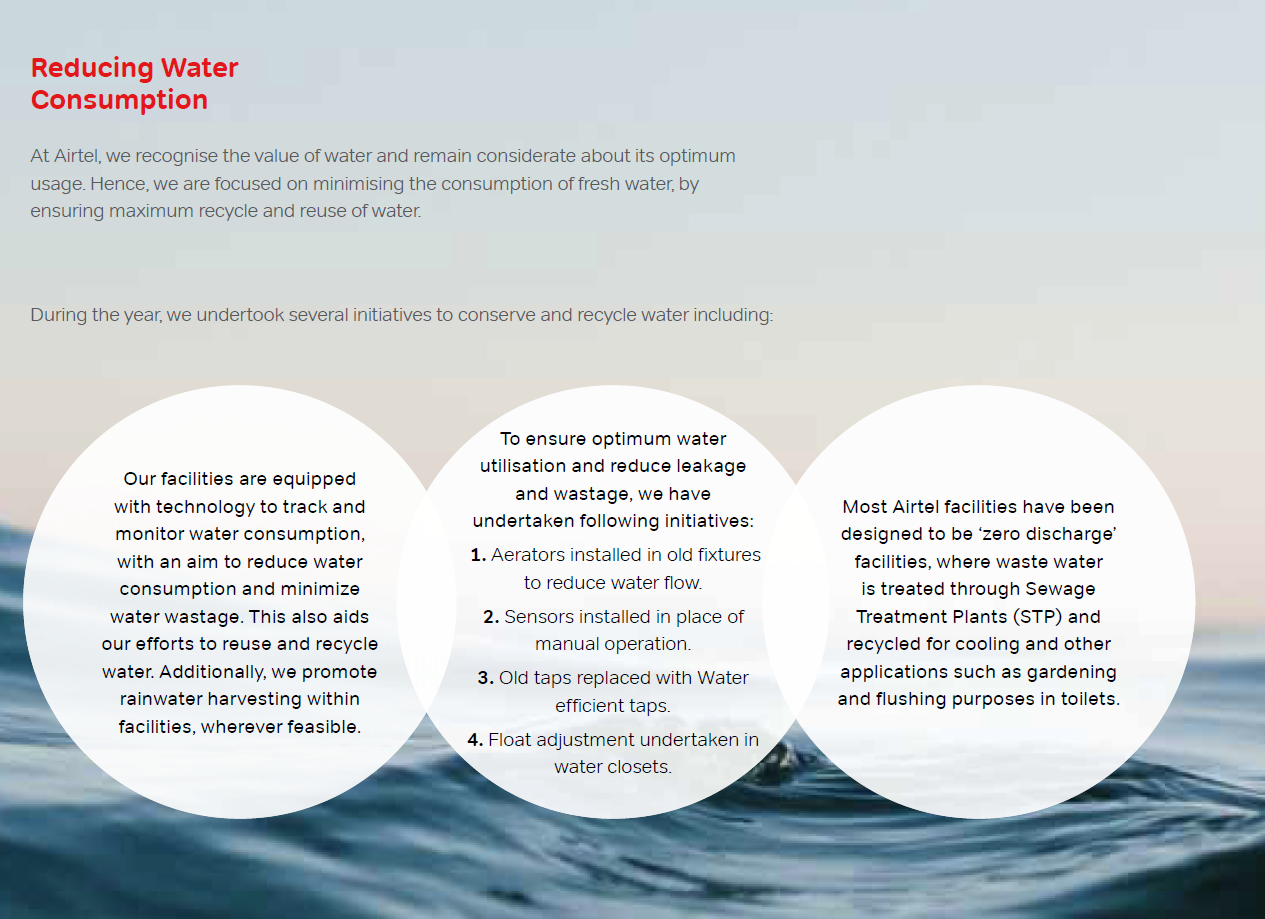AT AIRTEL, OUR EFFORTS AND INVESTMENTS ARE DIRECTED TO ENSURE ENVIRONMENTAL SUSTAINABILITY. WITH OUR STRATEGIC EFFORTS TO REDUCE AND RECYCLE, WE CONTINUE TO OPTIMIZE OUR OPERATIONS TO DERIVE EXCEPTIONAL SOLUTIONS THAT AUGUR WELL FOR A BETTER TOMORROW.
We, at Airtel, have identified 'Energy, Climate Change and Resource Optimization’ as one of our high priority material issues and have implemented various initiatives across operations to minimize our environmental impact. We believe that the evolving Information and Communications Technology Industry will play a pivotal role in defining the future. That is why, we strongly monitor our resource and energy consumption, greenhouse gas emissions and waste handling procedures, in an endeavour to adopt best practices for promoting sustainable telecom operations.
Along with our network-infrastructure partners, every year, we continue to make substantial investments to preserve natural resources and promote energy efficient technology and processes. We have invested in resource optimisation and energy conservation techniques to significantly reduce our ecological footprint. To inculcate environment-friendly practices, we are constantly trying to eradicate the use of fossil fuel in Airtel’s network infrastructure and data centers. As a result, we have adopted energy efficient towers to replace our existing towers and also increased the deployment of renewable energy in our data centers, Main Switching Centers and facilities. In the next few years, we aim to maximize the use of green energy sources to strengthen our sustainability agenda.


Our Approach
Our environmental commitment is reinforced through our comprehensive Environmental Management Policy. Further, our Environmental Management System addresses different areas of priority, as illustrated in the graphics below.
Our data centers comply with the requirements of ISO 14001:2015 Environmental Management System. At Airtel, environmental compliance is monitored by internal departments on an ongoing basis. We do everything we can, to uphold laws, policies and regulations related to the environment, safety and product standards of our operations.
Our consistent efforts to minimize our dependence on fossil fuel have largely contributed to our energy efficiency. We have also transitioned towards grid supply for our network infrastructure to ensure optimum energy consumption. Additionally, we promote resource optimisation and waste management initiatives to reduce our direct and indirect impacts on the environment.

Reduction in network emission intensity for mobile (carbon emissions per terabyte) from FY 2017-18
Reduction in CO2 emission per rack in our data centers from FY 2015-16
Diesel saved since FY 2015-16 in our own mobile network infrastructure
Renewable energy consumed in our operations
Paper recycled/reused in our facilities
Energy saved in our facilities
Paper saved through e-bill initiatives since FY 2011-12
Reduction in diesel consumption in our operations in FY 2019-20 as compared to FY 2017-18
Solar-enabled towers at owned and partner sites till FY 2019-20
Sheets of paper saved through acquisition of our mobile service customers
Increase in renewable energy deployment at our own operations from FY 2014-15
Network Infrastructure
- Maximizing Outdoor BTS – We converted 3,801 indoor Base transceiver station (BTS) sites to outdoor sites (with no air conditioner usage and reduced diesel consumption) in FY 2019-20 which resulted in lower demand for electricity and thereby, led to a 25% reduction in energy consumption.
- Site Sharing – We constantly strive to promote infrastructure sharing with our partners to optimise energy and resource consumption. This has not only enabled the effective utilization of passive infrastructure, but has also helped us reduce carbon emissions significantly. During the year, over 33% of the sites deployed were shared sites and it considerably reduced energy consumption in comparison to standalone sites.
- Lean Towers – In FY 2019- 20, we deployed 4,287 towers as Lean Towers i.e. towers that do not consume diesel to fulfil their energy requirement. This led to 40% reduction in energy consumption by these towers, thereby reducing carbon emissions (CO2) significantly.
- Auto Shutdown in Non-Peak Hours - In around 20,000 sites including all 4G sites, autoresource shutdown feature was implemented, which reduced the energy requirement at non-peak hours.
- Hybrid Battery Bank Solutions - We installed 1,137 sites with advance VRLA batteries and lithium-ion batterybased solutions to optimize energy consumption and reduce reliance on diesel, in FY 2019-20. Advanced batteries and Li-ion battery solutions were installed in 40,456 sites till March 2020, enabling us to reduce our diesel consumption by around 100 L per site, per quarter.
- Outdoor Conversion of Fiber Equipped Sites – Over 500 fiber equipped sites have been converted to outdoor sites by utilizing advanced transmission cooling units.
Reduction in network emission intensity for mobile (carbon emissions per terabyte) from FY 2017-18
of diesel saved since FY 2017-18 in our own mobile network infrastructure
Data Centers
- Ensuring Energy Efficiency - We installed energy efficient equipment and improvised processes across data centers to optimise cost, ensure power saving and reduce greenhouse gas emissions.
- Optimum Lighting - We were able to save 422,551 kWh of energy through lighting optimization, by installing LED lights and replacing fluorescent lights across data centers.
- Optimum Cooling - During the year, we saved 6,152,937 kWh of energy through cooling optimization across various data centers.
- Cold Aisle / Hot Aisle Containment- Through cold aisle / hot aisle containment at various locations, we saved 711,790 kWh energy.
- Power Factor Correction- This enabled us to save 51,79,498 kWh of energy during the year.
- UPS Optimization - We saved 3,694,957 kWh of energy by introducing UPS and SPMS optimization technology.
- Superior Solutions
- Installation of Energy Efficient Equipment.
- Installation of blanking panels to streamline air flow.
- Replacement of fluorescent tube lights with LEDs and installation of motion sensors.
- Replacement of old PACs with high CFM PACs.
- Replacement of Hipulse UPS with EXL high efficiency UPS and precision ACs.
- VFD installation in AHU motors & chiller pumps.
- Power Utilization Efficiency Correction.
Reduction in CO2 emission per rack from FY 2017-18
Energy saved in our data centers
Facilities
- UPS Optimization - We installed UPS optimisation technology across facilities, resulting in savings of 1,21,806 kWh energy in FY 2019-20.
- Electronically Computed (EC) Fans - During the year, we saved 5,34,023 kWh of energy by installing EC fans across various facilities (offices).
- Power Factor Correction - Power Factor Correction at our sites helped to save 37,500 kWh energy in FY 2019-20.
- Optimum Energy Conservation - Various other energy conservation measures such as installation of energy efficient lighting and motor sensors, facility consolidation and optimum space utilization, excess demand surrender, DG set capacity utilization etc. have been undertaken. These initiatives helped to reduce fuel consumption in our facilities and enabled optimum utilization of electricity.
Reduction in CO2 emission per square feet from FY 2017-18
Energy saved in our facilities
Embracing Green Energy
In an effort to reduce the environmental impact of our business operations, we are working along with our partners to embrace Green Energy in the form of solar energy, biomass, zero emission batteries etc. across our operations.
Rooftop Solar Plants
Over the last few years, we have installed rooftop solar PV plants at 27 locations {including Main Switching Centres and Data Centers}, expanding the total installed capacity to 1.47 MWp.
During FY 2019-20, we installed rooftop solar panels in some facilities and it helped to save 40,500 kWh of energy.
Green Power Wheeling Agreements
We signed Open Access Contracts or Green Power Wheeling Agreements in FY 2019-20 for procuring 73,320 MWh of power in our data centers and Main Switching Centers. These Green Power Wheeling Agreements will help us reduce CO2 emissions of around 60,856 tonnes per annum.
Solar-DG Hybrid Solution
A unique and innovative, Solar-DG Hybrid Solution uses 3 KW - 7 KW capacity solar panels along with battery banks to reduce DG running hours from 20 to 6 hours a day. The system is further optimized by a hybrid solar controller. We installed Solar DG Hybrid models with an installed capacity of 18 MWp, across 3,543 owned and partner network sites in India, reducing diesel consumption by more than 550 litres per month, for each site during FY 2019-20.
Project Green City
The project was launched few years ago in collaboration with our network infrastructure partners. Today, with our relentless efforts, over 63,843 sites have been tagged as green sites, consuming less than 100 litres of diesel per quarter.
Green energy procured in FY 2019-20 through various Green Power Wheeling agreements

Case study
Relying on Renewable Energy to Reduce Capex
Under Universal Service Obligation Fund (USOF), Airtel is undertaking a project in North East and Assam circles, to deploy 1,800 network sites. Majority of these sites are located in remote areas where Electricity Board (EB) availability is minimal. Further, taking into account the distance of sub-stations from our sites, sanctioning of EB from local state Electricity Board would involve a huge capital expenditure investment of over ₹ 20 lakhs.
To address this issue and reduce capital expenditure, Airtel has resorted to an innovative solution. We have initiated a Hybrid solution to install wind power of capacity 7.1 KWp, solar power of capacity 5.12 KWp and a Point of Connection to supply renewable energy. Some of the sites are now completely operating on green energy which has significantly reduced capital and operational expenditure.
Total savings with Hybrid Renewable Energy Solution

Our Impact
Our unwavering commitment to reduce emissions from operations has helped us sustain investments to acquire green energy, achieve efficiency, reduce demand and innovate clean energy solutions. The following graphs depict a comparative analysis of the emission intensity for the last few years in our network infrastructure, facilities and data centers. With the adoption of advanced technology, we strive to reduce emissions and make renewable energy more viable.
Emission Trends in Our Network Infrastructure

Reduction in network emission intensity for mobile (carbon emissions per terabyte) from FY 2018-19
Reduction in diesel consumption in our own mobile network infrastructure from FY 2015-16
Emission Trends in our Facilities

Reduction in network emission intensity for mobile (carbon emissions per terabyte) from FY 2018-19
Reduction in Grid CO2 emissions per square feet in our facilities from FY 2018-19
Emission Trends in our Data Centers

Procured from renewable energy sources
Decrease in diesel consumption as compared to FY 2014-15
Reduction in CO2 emission per rack in our data centers from FY 2015-16
Resource Optimisation and Waste Management
As part of our responsibility towards the environment, we are keen to optimize resources and minimize waste. Accordingly, we encourage reuse and recycling of water and paper within the organization. While waste water is recycled and utilized in washrooms and for gardening, we have significantly reduced our dependence on printed paper within the organization. We have also adopted efficient waste management techniques and in the current financial year, the waste disposed from our facilities was 38.95 tonnes.
Towards a Paperless Future
In our endeavour to reduce paper consumption, we continue to take significant steps to promote digital processes across our operations and have therefore, considerably reduced paper wastage.

E-Waste Management
E-waste occupies a predominant position in our waste generation portfolio. At Airtel, we strictly follow the Waste Electrical and Electronic Equipment (WEEE) guidelines to treat and reuse waste generated due to technological upgradation, capacity augmentation and other purposes. We are committed to responsibly treat e-waste and adopt the 3R approach of Reduce, Reuse and Recycle to enable maximum energy recovery.
The waste collected at the warehouse is segregated and dismantled for recycling and in some cases, recovered using chemical processes. All nonreusable hazardous waste including lead batteries are disposed through authorised recyclers, who have acquired requisite clearance from the Central / State Pollution Control Boards.
E-waste from IT and network infrastructure was responsibly recycled through our authorised partners.





